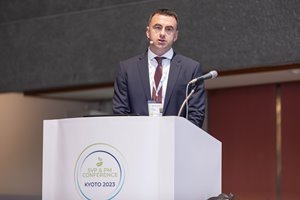Enhancing industrial safety at Krsko
Member Story
Band 33 Nein 1 2023
16 November 2023
 The Krško plant, located in Slovenia and operated by NEK, started operations in 1983. Recently we have achieved necessary conditions to extend lifetime and operate until 2043.
The Krško plant, located in Slovenia and operated by NEK, started operations in 1983. Recently we have achieved necessary conditions to extend lifetime and operate until 2043.
Our vision is to be a worldwide leader in nuclear safety and excellence. We are committed to looking at ways to continuously improve our plant.
To support this, we realised in 2019 that we needed to make improvements in industrial safety area, after WANO delivered a peer review and provided us with an Area for Improvement (AFI) relating to improving industrial safety.
The peer review recommended that we take preventative measures to ensure workers do not take industrial safety risks while performing their work. In particular we needed to take steps to improve behaviours across the plant, and of course, a key part of this was to first analyse what to do.
There were several causes and contributors but we found it was mostly caused by human behaviour and not enough willingness to work at the highest possible industrial safety standards, especially among contractors. Among some, there was a low awareness of importance of industrial safety, the rules around safe working were not always clear, managers did not consistently enforce safety standards to staff, and we didn’t always effectively analyse events and prevent their recurrence.
We defined four key areas to focus on:
• Working on heights
• Lifting and rigging
• Activities in high spaces
• And working on energised systems
As part of our solution, we asked WANO for help by setting up a member support mission. As part of our desire to improve, we asked to learn insights and experiences from a plant from our regional centre that had similar issues and had deployed effective actions for improvement. We took our management team to that plant to learn from them and how they managed to improve in that area. It was an extremely beneficial visit.
We discovered that the host plant had implemented a comprehensive and effective communications plan to change the culture and had a clear strategy and vision for improvement in the long run.
By learning from them, WANO and others in the industry, we were ready to define an improvement plan and implement the necessary actions.
The first was to communicate and reinforce industrial safety at all levels and areas of the plant. We conducted a communications campaign that focused on the four key areas previously mentioned. So a wide range of tactics were deployed; posters were put up over the plant, weekly safety messages were published through internal communication channels each week and conducted at meetings. Different areas of industrial safety were covered, once embedded this was then extended to also cover other topics.
We found that the industrial safety knowledge of the plant’s workers needed to be improved. So, we built a training centre near the plant so that everyone that came to work at the plant – employees and contractors – must attend training courses at the centre and learn how to perform tasks in as safe way as possible.
We also hired additional training staff who were specialists in safety work; in particular, they supported us in helping workers at the plant and implementing activities during outages.
Furthermore, we introduced several policies to apply from the senior management level down. We implemented a zero-tolerance policy to any deviations in high risk areas, and a stop work policy if there were any deviations from the norm. This meant that the work is immediately stopped and workers concerned needed to go through further training and evaluation before returning to work.
Another tactic was to introduce a clock with days since the last accident that we published internally so everyone could see it. This ensured the issue remained a key centre of focus and that all staff and contractors were engaged with what we were trying to achieve.
Furthermore, the Krsko plant’s leaders in the field programme set expectations for leaders to be more focused on industrial safety - with more than 500 observations now delivered by managers and leaders each year. Also, we made many observations and inspections on several construction sites on the plant.
We introduced additional Performance Indicators to track and measure our progress; for example number of near miss Industrial Safety Events, Industrial Safety Events Reset Days and Rate, etc.
We also checked unapproachable equipment in the plant, for which it is difficult to assure safe work when manipulations are needed. More than 12,000 components were checked, out of which critical ones were identified and solutions provided.
For work accidents (such as trips and falls) outside work areas, we evaluated areas which were potentially dangerous in the plant and defined actions to mitigate this.
Before the improvements were made, perhaps the mindset was that because we didn’t have any serious or fatal accidents, we didn’t have a problem. The challenge however was we had potential for fatal injuries, and so we took actions and changed the mindset and culture at the plant. Prevention is better than cure. This change took a lot of time to implement and needed the support of senior management.
In the last four years Krško has reduced the number of industrial safety events substantially. However, we will continue to drive excellence and continuous improvement to produce good, sustainable results.
My message is this. Do not wait for an accident to happen, act before it happens.
Mario Gluhak
Technical Director, Krško Nuclear Power Plant